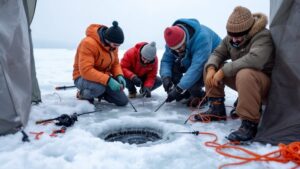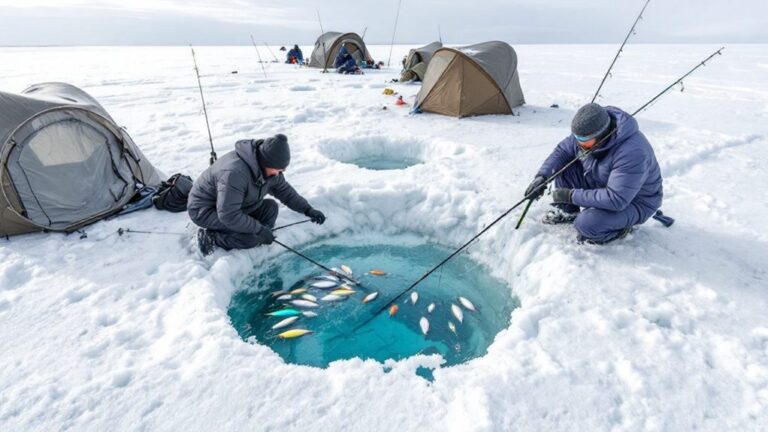Before heading out on your ice fishing adventure, prioritize these critical safety measures: First, verify ice thickness using a spud or chisel, ensuring at least 4 inches of clear ice. Always wear a personal flotation device and carry ice picks for self-rescue, along with a throw rope for emergencies. Research local conditions and share your detailed trip plans with family or friends. Maintain proper shelter ventilation and install a carbon monoxide detector if using a shanty. Keep emergency contact numbers handy and practice self-rescue techniques. With these fundamentals covered, you'll be ready to explore the exciting world of safe ice fishing.
Test Ice Before Venturing Out
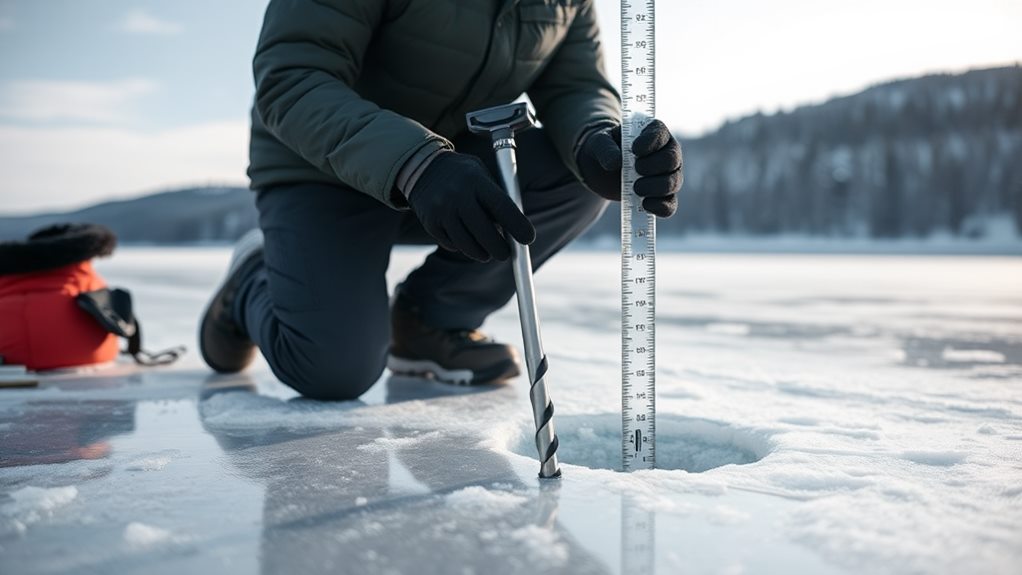
Before stepping onto a frozen lake, you'll need to verify the ice thickness using an ice spud or chisel. Don't rely on appearances alone – what looks like solid ice from the shore mightn't be safe enough to support your weight.
You'll want to test the thickness frequently as you move across the surface, ensuring there's at least 4 inches of clear ice beneath your feet.
Remember that ice conditions can vary dramatically within short distances, so don't assume the thickness is uniform. While one area might've a foot of solid ice, another spot just yards away could be dangerously thin at 1-2 inches.
Keep your safety gear handy and pay special attention to areas near the shoreline, where ice tends to be weaker.
Be particularly cautious when there's snow cover, as it can mask weak areas and insulate the ice, affecting its stability.
As you assess conditions, look carefully for warning signs like cracks or changes in the ice's texture. If you notice any suspicious spots or areas where water currents might compromise the ice's strength, it's best to find another location for your fishing adventure.
Essential Safety Equipment
Every successful ice fishing expedition starts with the right safety gear. When you're heading out onto the ice, your most important safety equipment includes a personal flotation device, which you should wear at all times, even if the ice seems solid.
Don't forget to pack ice picks or rescue claws, as these tools can literally save your life if you break through the ice by helping you grip the edges during self-rescue attempts.
Keep a throw rope within easy reach, as it's not just about your safety but also about helping others who might need assistance. You'll want to maintain communication capabilities too, so bring a portable power bank to keep your phone charged for reaching emergency services if needed.
If you're using an ice fishing shanty, proper ventilation is absolutely essential. Install a carbon monoxide detector to protect yourself from dangerous fumes that can build up from heating devices.
While it might seem like a lot of equipment to carry, remember that each piece serves a specific, potentially life-saving purpose. Think of these items as your ice fishing insurance policy – you hope you'll never need them, but you'll be grateful to have them if you do.
Plan Your Ice Fishing Trip
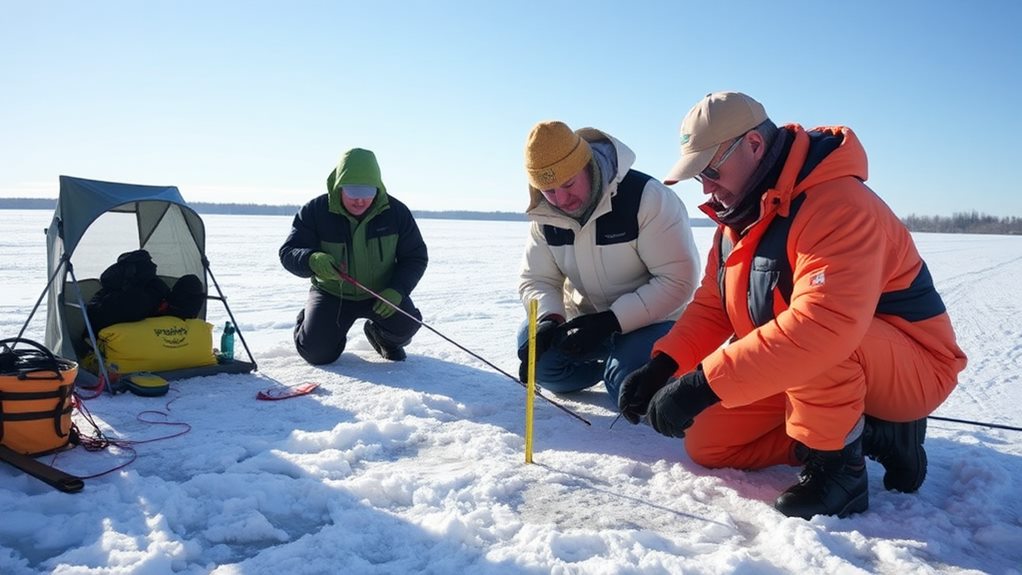
Successful ice fishing trips invariably begin with thorough planning and attention to timing. During the winter months, particularly from late December through early March, you'll find the best conditions for most fish species. Before heading out, thoroughly research ice thickness reports and monitor local weather patterns for your chosen location.
It's also wise to familiarize yourself with the ice fishing regulations in your area to guarantee compliance and promote conservation.
Safety should be your primary concern when planning your ice fishing trip. Always check ice conditions using an ice spud or chisel, guaranteeing there's at least 4 inches of clear, solid ice beneath your feet. Remember to carry a pair of ice picks and wear a flotation device, as these could save your life in an emergency.
Never venture out alone – ice fishing is safer and more enjoyable with companions. Share your fishing plans with family or friends, including specific details about your location and expected return time. Keep in mind that conditions can change rapidly, so maintain regular communication with those back home.
Before departing, create a detailed checklist that includes:
- Weather forecast verification
- Ice thickness testing equipment
- Emergency contact information
- Planned route and backup locations
- Expected departure and return times
Proper Shelter and Ventilation
Safe shelter conditions make the difference between an enjoyable ice fishing experience and a potentially dangerous one.
When setting up your proper shelter, you'll need to pay close attention to ventilation to prevent dangerous carbon monoxide buildup from heating devices. Keep windows or doors partially open, even if it means wearing an extra layer – your safety's worth it!
Installing a carbon monoxide detector in your enclosed space isn't just a good ice fishing safety tip – it's a potential lifesaver.
You'll want to regularly monitor the device and watch for any distress signs among your fishing buddies, especially during longer stays in the shelter. Remember, overcrowding can increase carbon monoxide risks and make the space uncomfortable for everyone.
Key safety measures to remember:
- Maintain proper airflow by keeping windows or doors partially open
- Install and monitor a carbon monoxide detector
- Keep a fire extinguisher readily accessible
- Avoid cramming too many people into your shelter
- Check on everyone's well-being periodically
Emergency Response Preparedness
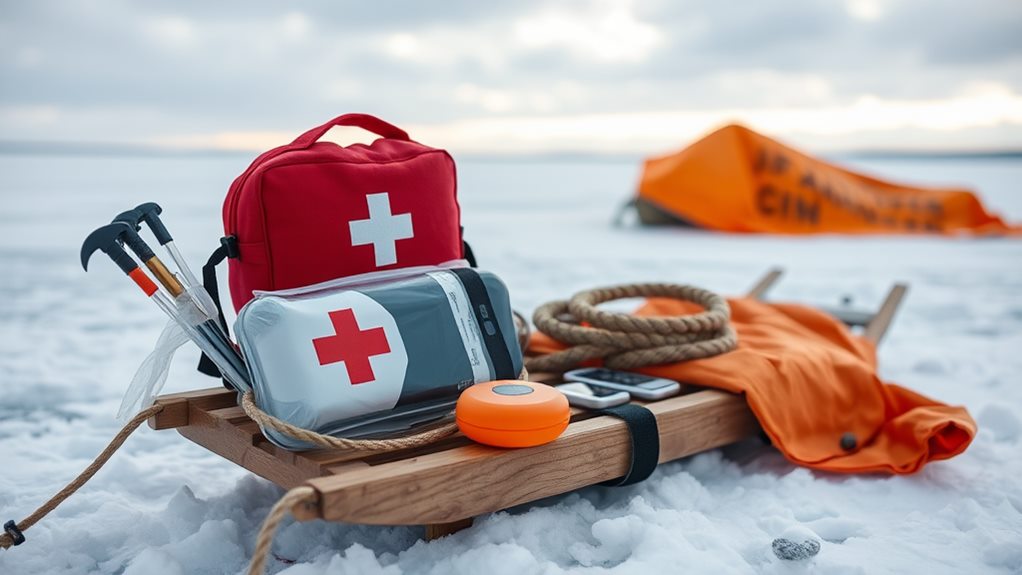
Beyond having a secure shelter, knowing how to respond to emergencies can mean the difference between life and death on the ice. Your ice safety preparation should start before you even step onto the frozen surface, with a detailed emergency plan that includes clear communication protocols with your fishing buddies.
Essential Safety Gear:
- Ice picks attached to your jacket
- A reliable rescue throw bag
- Whistle for signaling
- Well-stocked first-aid kit
- Personal flotation devices (PFDs)
Don't let the excitement of your fishing experience overshadow the importance of safety preparedness. In cold weather conditions, you'll want to practice self-rescue techniques regularly, so they become second nature.
Make sure you've memorized local emergency numbers and know the locations of nearby healthcare facilities – you don't want to be scrambling for this information during a crisis.
Before heading out, always share your detailed plans with someone you trust. Include your expected location, return time, and check-in schedule.
Frequently Asked Questions
How to Ice Fish Safely?
You'll need to check ice thickness (4+ inches), wear a PFD, carry safety gear like ice picks, and fish with buddies. Don't forget to monitor weather conditions and ice stability while you're out.
What Should You Not Do When Ice Fishing?
You shouldn't fish on thin ice under 4 inches, go alone, drink alcohol, drive vehicles on weak ice, or ignore warning signs like cracks. Don't skip safety gear or neglect to inform others about your plans.
What Is the Trick to Ice Fishing?
You'll catch more fish by using sonar to locate schools, fishing during dawn or dusk, and varying your jigging techniques. Pick bright-colored lures, and don't forget to match your bait to your target species.
How Do You Stay Safe While Fishing?
You'll stay safe by wearing a life jacket, checking weather forecasts, bringing safety gear, telling someone your plans, and avoiding risky conditions. Don't fish alone, and always keep emergency contacts handy.
Final Thoughts
Ice fishing can be an exhilarating winter activity when you're properly prepared for safety. By following these crucial guidelines, from testing ice thickness to carrying emergency gear, you'll greatly reduce your risk of accidents. Remember, conditions can change quickly, so stay alert and trust your instincts. Don't let safety concerns keep you from enjoying this wonderful sport – just make smart choices, and you'll create memorable fishing adventures while staying safe on the ice.

